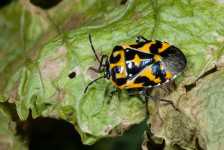Pest Of The Month: Harlequin Bug

Identification
This pest can destroy an entire crop when it is not controlled. The harlequin bug injures the host plants by sucking the sap of the plants. The bug literally “sucks-to-death” the host plant resulting in wilting, browning, and eventual death.
The adults are gaudy red-and-black-spotted stink bugs about 3/8 inch
long, flat, and shield-shaped. At rest, the front pair of wings overlap and the insect’s back appears to be marked with a distinct “X.”
Survival And Spread
Throughout most of its range, the harlequin bug feeds and reproduces during the entire year. In cooler areas, winter weather drives the bugs into the shelter of crop debris and other rubbish.
Harlequin bugs pass the winter as adults and true hibernation is doubtful. During the first few warm days of spring the adults emerge by the time the earliest transplants are set out.
A generation of the harlequin bug requires 50 to 80 days. The life cycle consists of three stages: egg, nymph, and adult.
The eggs of the harlequin bug resemble tiny white kegs standing on end. Approximately 12 are laid together in a double row, usually on the underside of the leaves of the host plant. Each egg is marked by two broad black “hoops” and a black spot. The eggs hatch in from four to 29 days, depending on the temperature.
There are five or six nymphal instars that feed and grow for four to nine weeks before they are capable of mating and laying eggs. The head coloration of the nymphs ranges from pale orange in the first instar, becoming darker, and finally black in the last instar. The thorax ranges from pale orange in first instars to a final pattern of scarlet, white, yellow, and black in the fifth or sixth instars. The abdomen coloration progresses similarly to that of the thorax, getting more colorful with each progressive molt.
Management Methods
Destruction of the adults in the fall and spring as they emerge from “hibernation” before they lay eggs is an effective control. This may be aided by the use of trap crops of turnip, kale, or mustard in the very early spring or late in the fall after the main crop has been harvested.
Once the pests have concentrated in these areas, they can be killed by applying insecticides or by covering the trap crop with straw and burning. Trap crops should not be employed unless they can be given careful attention to destroy the bugs attracted to them.
Harlequin bugs may be controlled with insecticides applied to the foliage.
Consult UF/IFAS recommendations for currently labeled insecticides for harlequin bug control in Florida vegetables.










